AI tools for audience segmentation can transform your marketing by analyzing customer data in real time, leading to more personalized and effective campaigns. Here’s a quick overview of the top 10 AI tools that marketers are using to improve conversion rates, reduce costs, and enhance customer experiences:
- Lifemind: Focuses on value-based profiles without requiring personal data, ensuring privacy compliance.
- Optimove: Combines historical data, real-time tracking, and predictive analytics for precise segmentation.
- Segment.io: Centralizes event data from multiple sources for better customer insights.
- Dynamic Yield: Personalizes experiences across touchpoints with advanced segmentation.
- Kissmetrics: Tracks individual customer journeys and behaviors to create targeted campaigns.
- Mailchimp: Offers AI-powered segmentation for small to medium businesses with automation features.
- Usermaven: Privacy-first analytics with dynamic, real-time segmentation.
- SuperAGI: Uses predictive machine learning for real-time segmentation and multi-channel integration.
- Bloomreach: Combines customer data and search algorithms for personalized e-commerce experiences.
- Qualtrics: Leverages sentiment and intent analysis for dynamic segmentation, with strong privacy measures.
These tools cater to various industries, including e-commerce, SaaS, and B2C, with features like real-time analytics, privacy compliance, and seamless integrations. Whether you’re a small business or an enterprise, there’s a tool to meet your needs.
Quick Comparison
| Tool | Key Features | Best Use Cases | Pricing | Privacy Compliance |
|---|---|---|---|---|
| Lifemind | Value-based segmentation, no PII | E-commerce, retail | Custom pricing | CCPA compliant |
| Optimove | Predictive analytics, multi-channel | Retail, gaming, subscriptions | Not disclosed | GDPR, CCPA compliant |
| Segment.io | Centralized data, real-time tracking | SaaS, mobile apps, e-commerce | Starts at $120/month | SOC 2, GDPR, CCPA compliant |
| Dynamic Yield | Personalization, A/B testing | E-commerce, travel | Custom pricing | GDPR, CCPA compliant |
| Kissmetrics | Behavioral tracking, funnel analysis | SaaS, subscriptions | Custom pricing | GDPR, CCPA compliant |
| Mailchimp | Automated workflows, AI segmentation | SMBs, content marketing | Free to $10/month | GDPR, CCPA compliant |
| Usermaven | Privacy-first, dynamic segmentation | SaaS, e-commerce | Freemium | GDPR, CCPA compliant |
| SuperAGI | Predictive insights, multi-channel | Enterprise, marketing | Not disclosed | Enterprise-grade security |
| Bloomreach | AI-powered personalization | E-commerce, retail | Custom pricing | GDPR, CCPA compliant |
| Qualtrics | Sentiment analysis, Experience ID | Enterprise, B2C | Custom pricing | FedRAMP, GDPR, CCPA |
These tools are designed to make segmentation smarter, faster, and more effective, helping businesses of all sizes create campaigns that resonate with their target audiences.
How to Build Customer Segments with AI (Real-World Use Case)
1. Lifemind
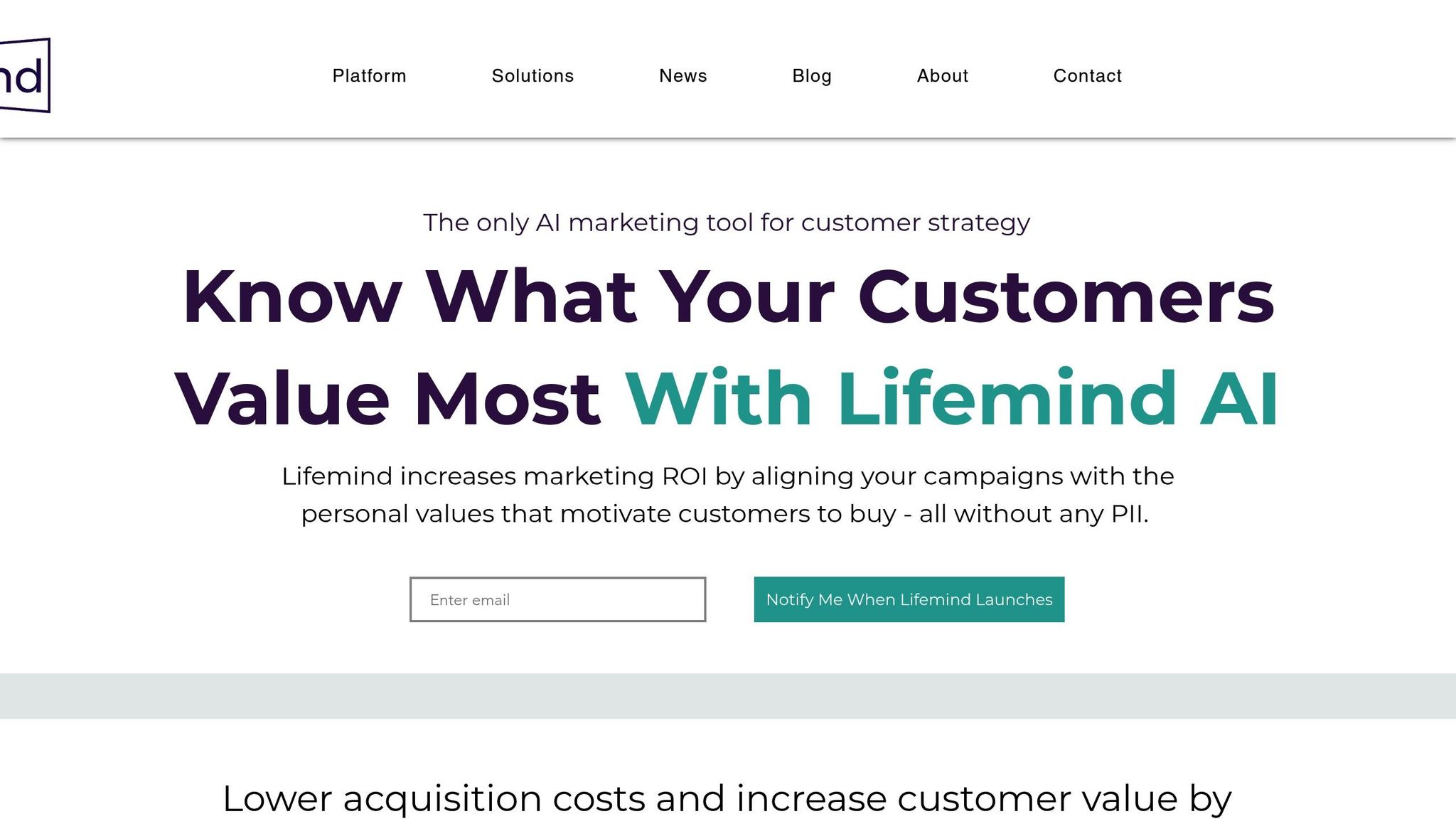
Lifemind takes a fresh approach to audience segmentation by focusing on personal values instead of traditional demographics or behaviors. Using AI, the platform organizes audiences into 189 proprietary value-based profiles, offering detailed insights into what drives customer decisions.
For U.S. marketers, this platform stands out by eliminating the need for PII, CDP integration, or consent flags. Simply upload ZIP-level customer counts, and Lifemind generates value-driven profiles along with actionable targeting recommendations.
Real-time Analytics Capabilities
Lifemind delivers insights in just minutes. It provides ZIP-level data across the entire U.S., making it scalable for both local campaigns in specific cities and nationwide brand initiatives. This speed allows marketers to test various value-based segments quickly and adjust their messaging on the fly, based on performance metrics.
What sets Lifemind apart is its ability to go beyond basic segmentation. It offers guidance on emotional tone, message structure, and creative framing for each of its 189 personas. This level of detail helps marketing teams not only identify their audience but also craft messages that resonate deeply.
Privacy Compliance for U.S. Markets
In addition to its speed and depth, Lifemind prioritizes data privacy. With 73% of Americans expressing greater concerns about data privacy compared to a few years ago, Lifemind’s approach is timely. The platform operates without PII, simplifying compliance with various U.S. state privacy laws, including California’s CCPA, Colorado’s CPA, and others in Virginia, Connecticut, and beyond.
This privacy-first design addresses a critical trust issue: 94% of organizations acknowledge that customers are unlikely to buy from them if they feel their personal data isn’t secure. By eliminating the need for PII, Lifemind lowers barriers to consumer trust and regulatory compliance.
Integration with Marketing Platforms
Lifemind’s ease of use extends to its integration capabilities. Instead of requiring complex technical setups, it delivers ready-to-use creative and targeting strategies adaptable to any media mix. By enriching first-party data with psychographic insights, the platform helps media teams enhance campaign performance across existing advertising tools.
David Nyurenberg, Media Director at Rain, highlighted the platform’s impact:
"Our collaboration with Lifemind has improved efficiency and reduced acquisition costs."
The platform offers targeting recommendations that media teams can implement immediately, eliminating the need for additional technical steps. This streamlined process allows marketers to begin testing value-based segments within a week of setup.
Use Case Versatility
Lifemind is ideal for agencies and brands aiming to define audiences by emotional and behavioral values rather than demographics. With its 189 value-based personas, the platform addresses a wide spectrum of consumer motivations. This makes it a fit for everything from e-commerce brands targeting niche lifestyle groups to B2C companies exploring what drives buying decisions in different regions.
Its ZIP-level granularity is particularly useful for businesses with location-specific strategies, such as retail chains, regional service providers, or brands testing market expansion into new areas.
2. Optimove
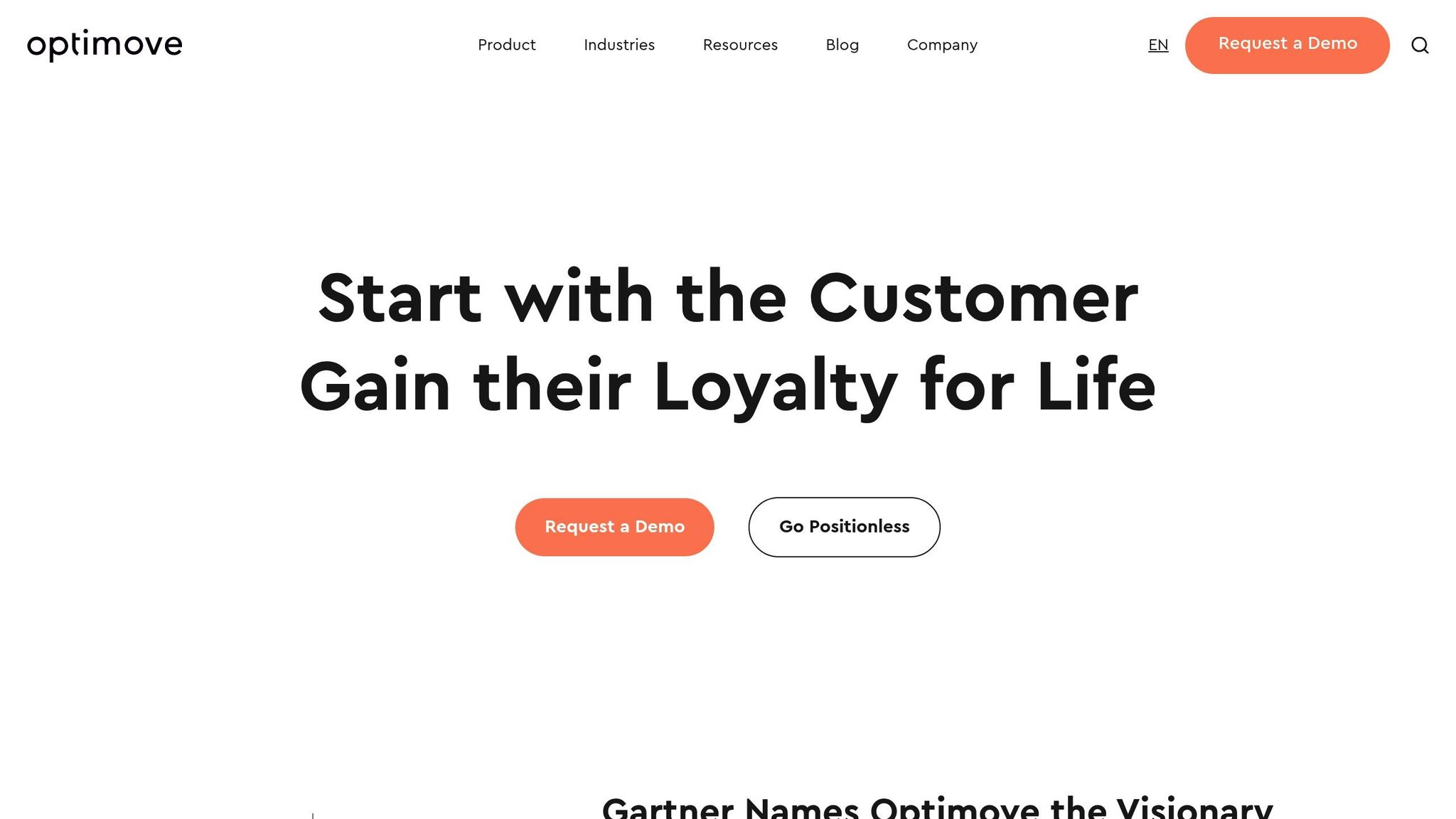
Optimove offers a dynamic approach to audience segmentation by combining historical customer data, real-time activity tracking, and predictive analytics. This synergy allows marketers to create campaigns that respond instantly to customer behavior, ensuring a highly personalized experience. By leveraging past interactions, live data, and AI-driven predictions, the platform achieves a level of segmentation that’s both precise and timely.
Real-Time Analytics Capabilities
Optimove’s no-code interface empowers marketers to build and refine customer segments on the fly. Research shows that segments with up to 4,999 customers yield an average revenue boost of about $20.93 per customer, outperforming both smaller and larger groupings. This ability to adapt in real time forms the backbone of Optimove’s advanced targeting tools.
Shai Frank, Optimove’s VP of Product, highlights this advantage:
"By blending realtime, historical, and predictive segmentation, we provide CRM marketers with the most robust set of targeting capabilities in the market, further helping brands to significantly increase their customers’ value."
Privacy Compliance for U.S. Markets
Optimove operates under strict privacy guidelines and is certified by several U.S. Department of Commerce frameworks, including the EU-U.S. Data Privacy Framework (and its UK Extension) and the Swiss-U.S. Data Privacy Framework. The platform emphasizes user privacy, offering opt-out options through marketing preference pages and online forms. As Optimove states:
"At Optimove, we value your privacy and are committed to preserving it. We aim to be as transparent as possible with how we collect and process your data and personal information. We never sell personal data and we carry out all processing operations in strict compliance with the EU General Data Protection Regulation (‘GDPR’)."
Integration with Marketing Platforms
Optimove simplifies complex segmentation tasks with its user-friendly web interface. It also integrates seamlessly with other marketing platforms, enabling automated campaign management across multiple channels. Customer segments and targeting are updated dynamically in real time, ensuring campaigns stay relevant and effective. This adaptability makes the platform useful across a wide range of industries.
Use Case Versatility
With over 500 brands relying on its capabilities, Optimove serves industries like retail, e-commerce, gaming, entertainment, financial services, and apps. Its flexible design supports applications such as:
- Gaming: Operators can use predictive responsible gaming attributes alongside real-time data to shift players nearing self-set loss limits from promotional campaigns to messages promoting responsible gaming.
- E-commerce: The system updates lifecycle-based segmentation with every transaction, automatically excluding recent buyers from churn-targeted campaigns.
- Retail: By combining customer preferences, churn risk predictions, and real-time purchase data, brands can determine the next best offer for customers at risk of leaving.
Real-world examples highlight Optimove’s impact. Musti, a Nordic pet care brand, achieved campaigns where 89% targeted less than 0.02% of its customer base. Meanwhile, BetMGM uses the platform to gain deeper behavioral insights. Claus Hansen, Director of CRM at BetMGM, shares:
"We are using Optimove to maximize customer lifetime value in a lot of different ways. That allows us to identify what we need to do with different customer cohorts really early on and understand how to act throughout the different journeys to ultimately maximize the lifetime value."
Optimove clients report an average 33% boost in Customer Lifetime Value and an 88% improvement in campaign efficiency.
3. Segment.io
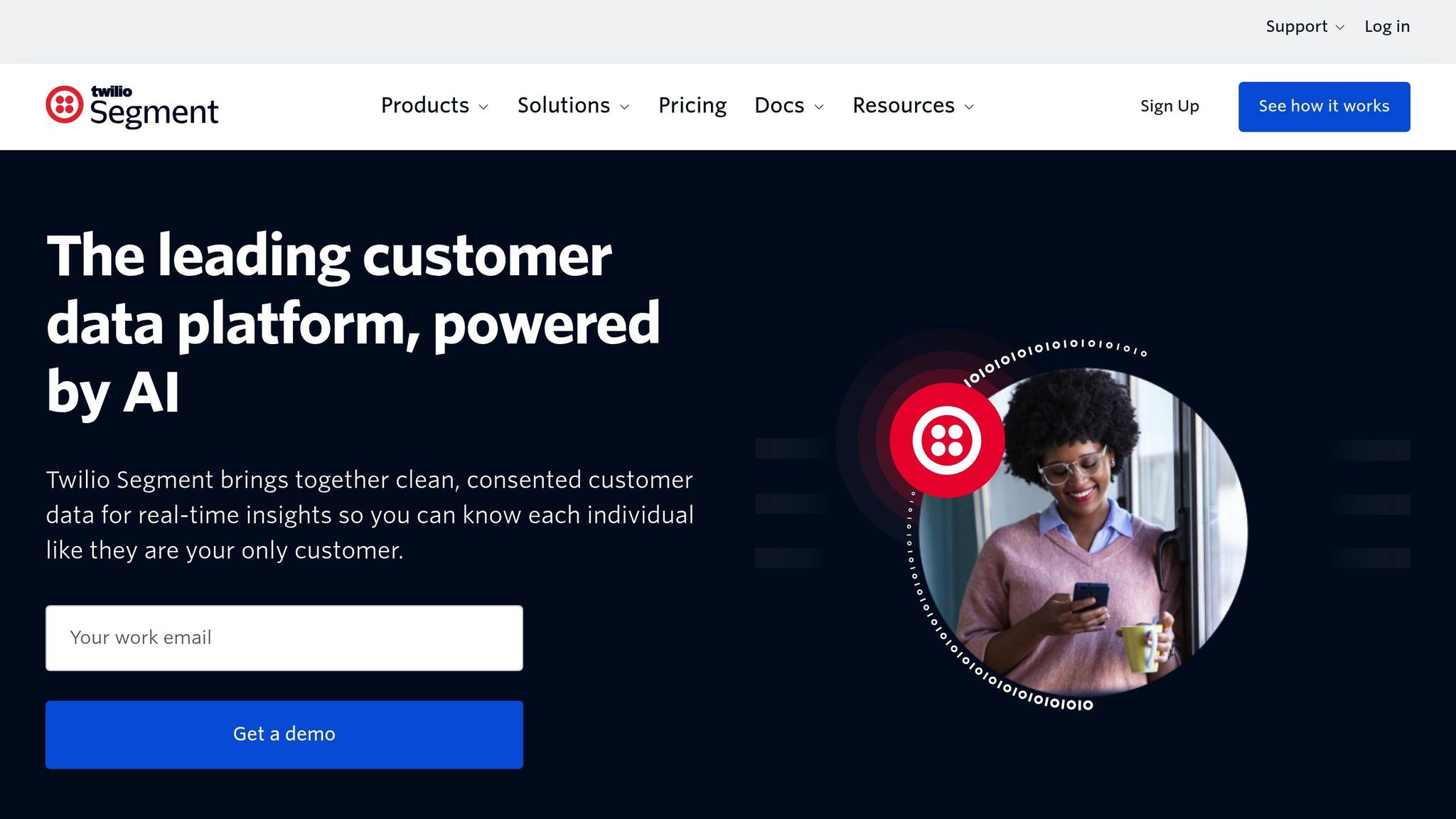
Segment.io brings together event data from various channels, offering businesses a clearer understanding of their audience. Unlike older segmentation tools, Segment acts as a centralized hub, connecting customer data across your marketing tools to provide a solid foundation for smarter insights.
Real-Time Analytics Capabilities
Segment excels at handling real-time event data and building responsive audience segments. Using its Connections feature, the platform gathers data from multiple sources and streams it in real time, capturing actions like purchases, page visits, or app interactions. This data becomes instantly available for audience segmentation.
Through machine learning, Segment’s real-time audience builder analyzes customer behaviors and preferences across different channels. When certain criteria are met, users are automatically grouped into specific audiences, enabling quick responses to behavior-based triggers. However, while event processing happens in real time, syncing these audiences with marketing platforms typically occurs in batches every 2–3 hours. Additionally, marketers can use the Profile API to access complete user profiles for personalized campaigns and in-app experiences.
Privacy Compliance for U.S. Markets
Segment prioritizes privacy, offering tools to help businesses comply with the California Consumer Privacy Act (CCPA). It simplifies processes like consumer data deletion and access requests. The platform’s Privacy Portal enhances transparency by automatically discovering and masking sensitive data, ensuring businesses can handle suppression or deletion requests on a large scale.
Segment’s "Privacy By Design" approach includes a Data Processing Agreement tailored to CCPA guidelines and the appointment of a Data Protection Officer to oversee compliance efforts. All transmitted data is encrypted, both at rest and in transit, addressing concerns about data security – especially given IBM’s report that the average cost of a data breach exceeds $4 million globally.
Tido Carriero, Segment’s Chief Product Development Officer, emphasizes their commitment to data security:
"The thing we’ve always been best at (data infrastructure) had another reason to be done well."
This dedication paid off when, one year after GDPR’s rollout, Segment successfully deleted nearly 7 million users from its platform and connected tools.
Integration with Marketing Platforms
Segment integrates with hundreds of marketing platforms, spanning categories like A/B testing, advertising, analytics, CRM, and email marketing. Its standout feature is the ability to send analytics data to multiple services without requiring separate integrations. As Segment explains:
"Segment.com lets you send your analytics data to any service you want, without you having to integrate with each one individually."
This streamlined approach allows businesses to switch between tools effortlessly – no need for website updates, manual data imports, or concerns about data loss. Popular integrations include platforms like Google Analytics, HubSpot, Salesforce, Marketo, Mixpanel, and Intercom. This flexibility opens doors to countless applications.
Use Case Versatility
Segment proves useful across industries and business models, offering a 360-degree view of customers without requiring heavy technical resources. For e-commerce, it unifies data from various channels to deliver insights into customer behavior and preferences. SaaS companies benefit from its predictive analytics, which help forecast trends, while its seamless integration with marketing automation tools, CRMs, and data warehouses drives better ROI.
B2C brands also leverage Segment for managing multichannel customer journeys, combining detailed audience segmentation with tools for improving the overall customer experience. Businesses using advanced AI-driven segmentation tools like Segment have reported a 35% boost in customer engagement and a 25% rise in conversion rates compared to traditional methods.
4. Dynamic Yield
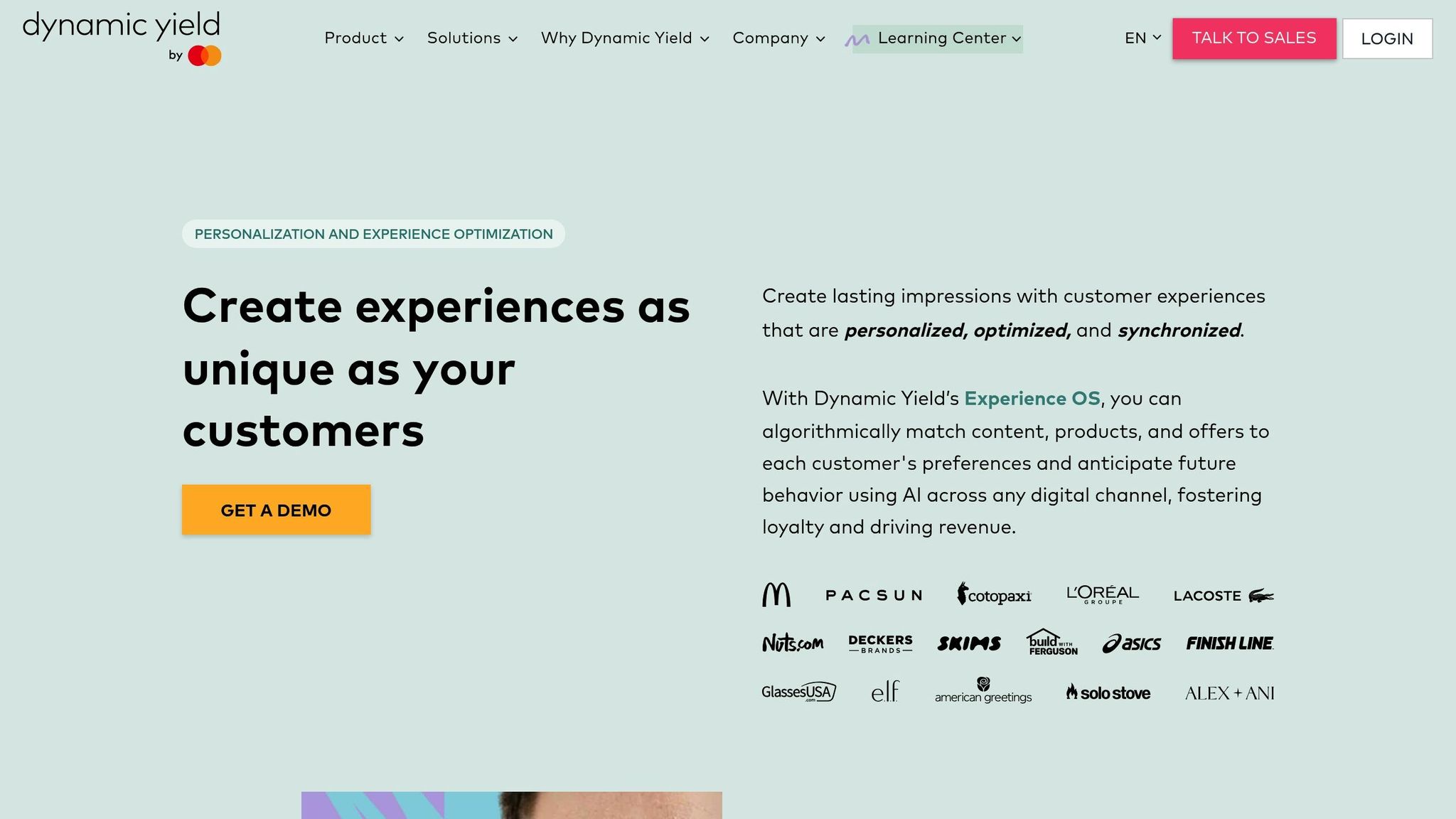
Dynamic Yield is a comprehensive personalization platform that uses real-time data and advanced audience segmentation to create tailored experiences across various customer touchpoints. Acquired by Mastercard in 2021, this AI-driven tool combines deep audience insights with actionable features to deliver impactful personalization strategies.
Real-Time Analytics Capabilities
Dynamic Yield’s Audience Explorer provides instant previews of user segments by applying filters like device type, location, and specific user actions. The platform pulls data from multiple sources – user properties, behavioral trends, and even off-site CRM systems – to uncover opportunities for optimization and personalization. Yaniv Navot, Dynamic Yield’s CMO, explains:
"With customer data management and real-time audience segmentation, marketers can efficiently analyze data and discover optimization opportunities, and quickly act upon it through personalization campaigns."
For instance, while mobile users account for over 50% of website traffic, they contribute to less than 20% of purchases. By segmenting cart abandoners and sending targeted discount notifications, businesses can recapture lost sales. This real-time approach is especially valuable when considering that just 0.5% of digital data is analyzed.
Dynamic Yield’s analytics capabilities integrate seamlessly with leading marketing platforms, enhancing its personalization potential.
Integration with Marketing Platforms
Dynamic Yield is designed to work within existing marketing ecosystems, connecting with tools like e-commerce platforms, email marketing systems, and web analytics solutions. This integration ensures synchronized data and allows businesses to deliver personalized campaigns across multiple channels.
| Integration Partner | Key Benefit | Use Case Example |
|---|---|---|
| Listrak | Trigger personalized emails within Dynamic Yield | Reconnect with users by sending customized emails to those who abandoned browsing sessions. |
| Salesforce Marketing Cloud | Deliver unified recommendations across site and email | Share product suggestions with users exploring specific categories. |
| Mailchimp | A/B test and optimize emails with dynamic content | Add tailored product recommendations to campaigns targeting high-intent shoppers. |
| Segment | Streamline data synchronization | Sync real-time behavior data for more accurate product recommendations. |
| mParticle | Automate script implementation and event tracking | Provide personalized experiences across devices for subscription-based customers. |
These integrations yield tangible results. For example, SnapAV saw a 40% to 60% rise in click-through rates for recommended products, while Dormify achieved a 34% boost in mobile add-to-cart rates after implementing a mobile-specific page layout.
Use Case Versatility
Dynamic Yield’s adaptability makes it a valuable tool across various industries and business models. E-commerce businesses, in particular, see significant benefits, with personalized product recommendations accounting for 25% of revenue. More specifically, PDP (Product Detail Page) recommendations can raise average revenue per user (ARPU) by 4.2%, personalized recommendations increase ARPU by 5–7%, and add-to-cart suggestions drive a 15% ARPU lift.
The platform’s versatility also supports SaaS companies and B2C brands aiming to enhance customer journeys. Brian Schmitt, Co-Founder of Surefoot, highlights its impact:
"Dynamic Yield enables us to develop and test high-impact experiences for our clients, and gives them flexibility to update and manage those experiences once they are proven effective."
For businesses seeking to refine audience segmentation and deliver tailored customer experiences, Dynamic Yield offers a powerful combination of real-time analytics, seamless integrations, and measurable results. Its ability to adapt to diverse needs ensures it remains a go-to solution for driving meaningful outcomes.
5. Kissmetrics
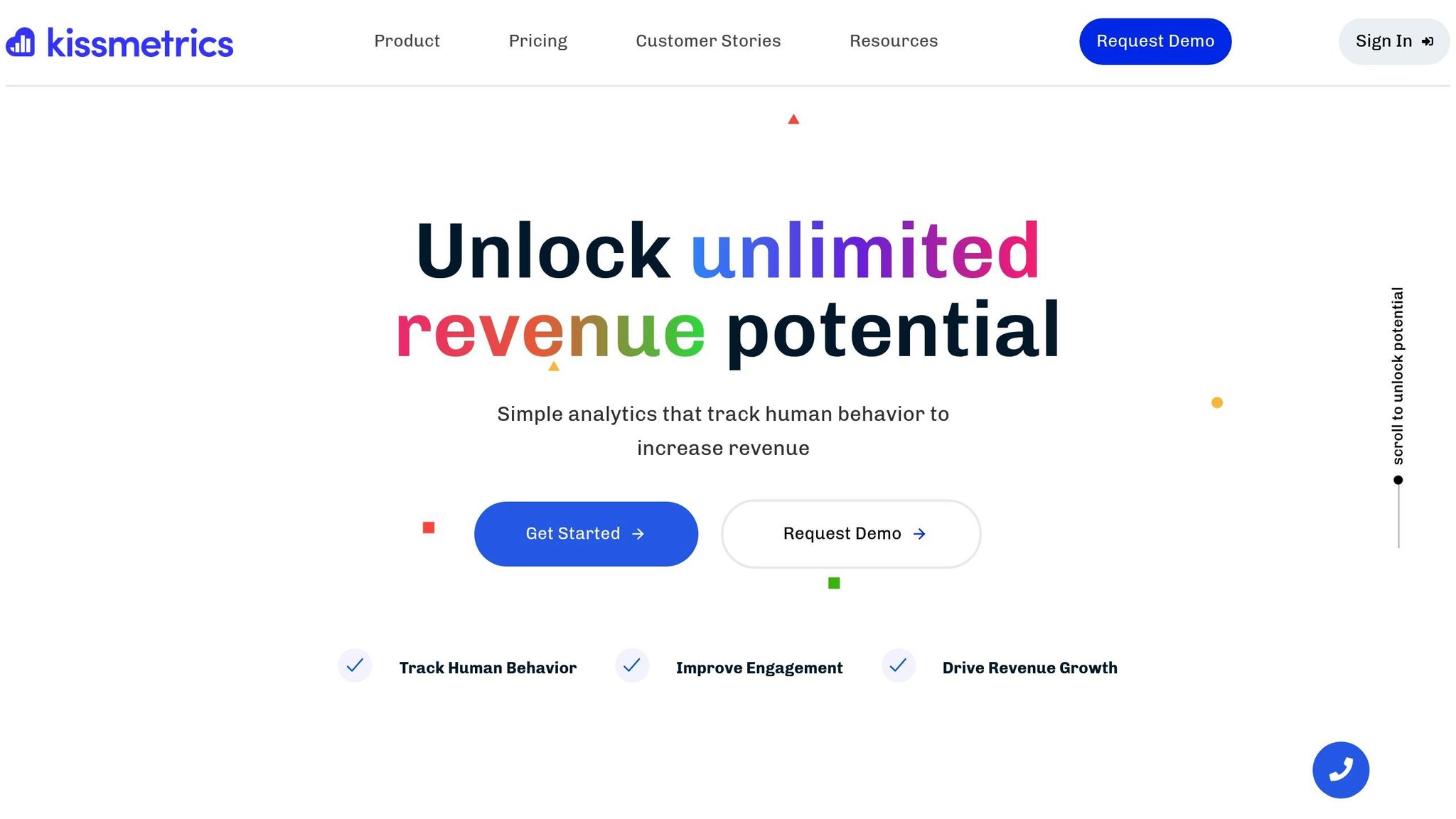
Since 2010, Kissmetrics has been a go-to platform for person-based analytics, earning the trust of over 10,000 companies. What sets it apart is its ability to link every customer action to an individual, enabling precise segmentation and highly personalized marketing campaigns. Unlike traditional analytics tools that focus on sessions and pageviews, Kissmetrics digs deeper, tracking behaviors at the individual level.
Real-Time Analytics Capabilities
Kissmetrics stands out by offering detailed tracking of customer behavior throughout their entire journey – from the moment they visit your site to when they complete a purchase. The platform processes millions of events daily and has managed over $10 billion in transactions. It’s particularly adept at identifying actions that signal purchase intent, such as adding products to a cart or interacting with customer support. This level of detail allows businesses to create laser-focused audience segments based on real user behavior.
Alex Acker, Senior Manager of Marketing & Insights at Ntiro, shares:
"Kissmetrics provided us the ability to track unique events and segment who the users are and what each user is doing. Google Analytics doesn’t allow that."
Kissmetrics also offers sales funnel analytics, which map out every step of the customer journey. This feature helps businesses identify exactly where customers drop off, uncovering behavioral trends that can inform re-engagement strategies.
Integration with Marketing Platforms
Kissmetrics integrates seamlessly with popular marketing tools, making it easier to manage audience segmentation across various channels. Some key integrations include:
- ActiveCampaign for tracking customer events
- CallTrackingMetrics to merge call data with behavioral insights
- Hotjar for filtering heatmap and session recording data using Kissmetrics Customer IDs
Additionally, the platform connects with WooCommerce and Live Chat systems for cross-channel analysis. Tools like Segment.io can send data into Kissmetrics to provide deeper behavioral insights. For A/B testing, the Kameleoon integration uploads test and personalization data, enriching campaign analysis. These integrations make it easier for marketers to gain actionable insights across platforms.
Use Case Versatility
Kissmetrics proves to be a valuable tool for businesses across various industries, particularly in e-commerce, SaaS, and B2C sectors. Its impact is evident in the success stories of its clients. For instance, Smart Insights boosted their monthly revenue by 120% through data-driven decision-making, while PagerDuty saw a 25% increase in trial engagement using Kissmetrics Cohort Reports. By tracking user behavior during trial periods and pinpointing conversion triggers, SaaS and B2C companies can turn raw data into actionable strategies.
Spencer Mann, VP of Growth at LucidChat, highlights the platform’s role in optimizing conversions:
"Insights from Kissmetrics drove a 30% lift in our conversions. All of our key customer behavior data lives in Kissmetrics, for both our product and our website. We can quickly identify and take action on any roadblocks across our growth cycle. Kissmetrics is essential to Lucid Software’s growth efforts."
Kissmetrics also excels in automated email marketing and messaging. By setting up behavior-triggered sequences, marketers can create highly relevant campaigns that respond to specific customer actions. This makes the platform particularly effective for nurturing leads and driving engagement.
For businesses aiming to understand their customers on a deeper level and create precise, behavior-based audience segments, Kissmetrics delivers a proven solution with real, measurable results across industries.
6. Mailchimp
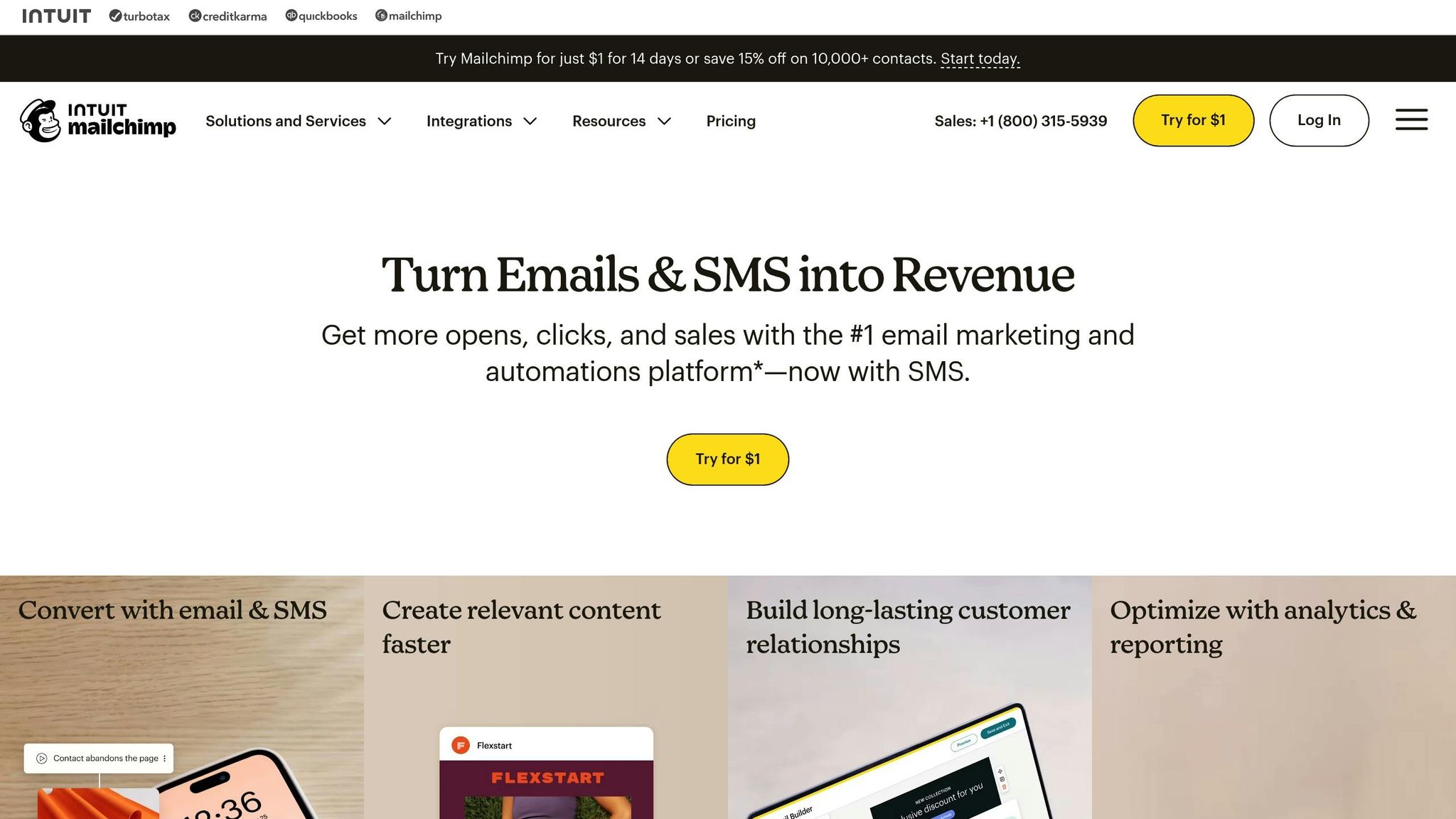
Mailchimp has grown into a robust AI-powered segmentation platform, delivering over 8 million recommendations to help businesses build dynamic customer segments based on behavior, purchase history, and engagement patterns. By analyzing detailed data points like browsing habits, sentiment, and online interactions, it enables highly personalized marketing experiences.
This focus on audience segmentation provides real-time insights that are particularly valuable for e-commerce and B2C marketers.
Real-Time Analytics Capabilities
Mailchimp’s AI-driven analytics go beyond basic demographic data, offering actionable insights that can make a real difference. For instance, predictive segmented emails led to a 266% revenue boost during Mailchimp’s e-commerce tests from January 2023 to December 2024.
The platform’s AI tools automate tasks like A/B testing, subscriber segmentation, and content personalization, significantly improving performance. Automated emails within marketing flows have shown to increase click rates by up to 115% compared to bulk emails. This automation frees up marketers to focus on strategy while the AI fine-tunes the technical details.
Snigdha Sur, Founder and CEO of The Juggernaut, shared her experience with Mailchimp’s segmentation:
Our most effective campaigns came from using Mailchimp’s existing segmentation, where we used the Mailchimp API to tag our customers based on their engagement and whether they paid us. We relied heavily on that data when we did marketing activities, and that’s where we saw really good conversion, which was super helpful.
Integration with Marketing Platforms
Mailchimp’s ability to integrate with other platforms enhances its segmentation capabilities even further. It connects seamlessly with major e-commerce platforms like Shopify, Magento, WooCommerce, and BigCommerce, enabling businesses to track purchase activity and create segments based on customer buying behavior.
The platform also integrates with CRMs such as HubSpot, Zoho CRM, Pipedrive, Freshsales, and Salesforce. These connections allow for automated data syncing and more detailed customer journey mapping. Additionally, Mailchimp provides API access for custom integrations, so businesses can pull data from tools like LinkedIn Lead Gen Forms. This makes it possible to segment contacts by acquisition channel, resulting in more targeted campaigns.
Use Case Versatility
Mailchimp’s AI-powered segmentation is highly effective across a range of industries, particularly in e-commerce and B2C marketing. For e-commerce, its AI tools analyze customer preferences, browsing behavior, and purchase history to create personalized email campaigns. These campaigns often feature tailored subject lines and product recommendations, leading to higher open rates and increased revenue.
Lauren Korus, Content Manager at Vacation Races US, highlighted the benefits of Mailchimp’s segmentation:
Mailchimp segmentation is straightforward, and using it has allowed us to better target groups with different campaigns. Better targeting has allowed us to achieve improved results.
But Mailchimp’s versatility isn’t limited to e-commerce. In real estate, for example, its AI tools can analyze property values, neighborhood trends, and client data to match properties with individual client preferences, leading to higher engagement and faster sales.
Jack Tadd, Managing Director at Warm Glass UK, emphasized the time-saving benefits:
The copy is a perfect starting point, and making changes would take just a few minutes rather than taking half an hour. It’s like having that digital assistant that allows you to become an editor rather than a writer.
Looking ahead, Mailchimp is set to release new features in 2025, including the ability to export custom audience segments to ad platforms like Meta and Google for advanced targeting. These updates will further enhance its cross-channel segmentation capabilities, offering businesses even deeper audience insights.
sbb-itb-d6d4d8b
7. Usermaven
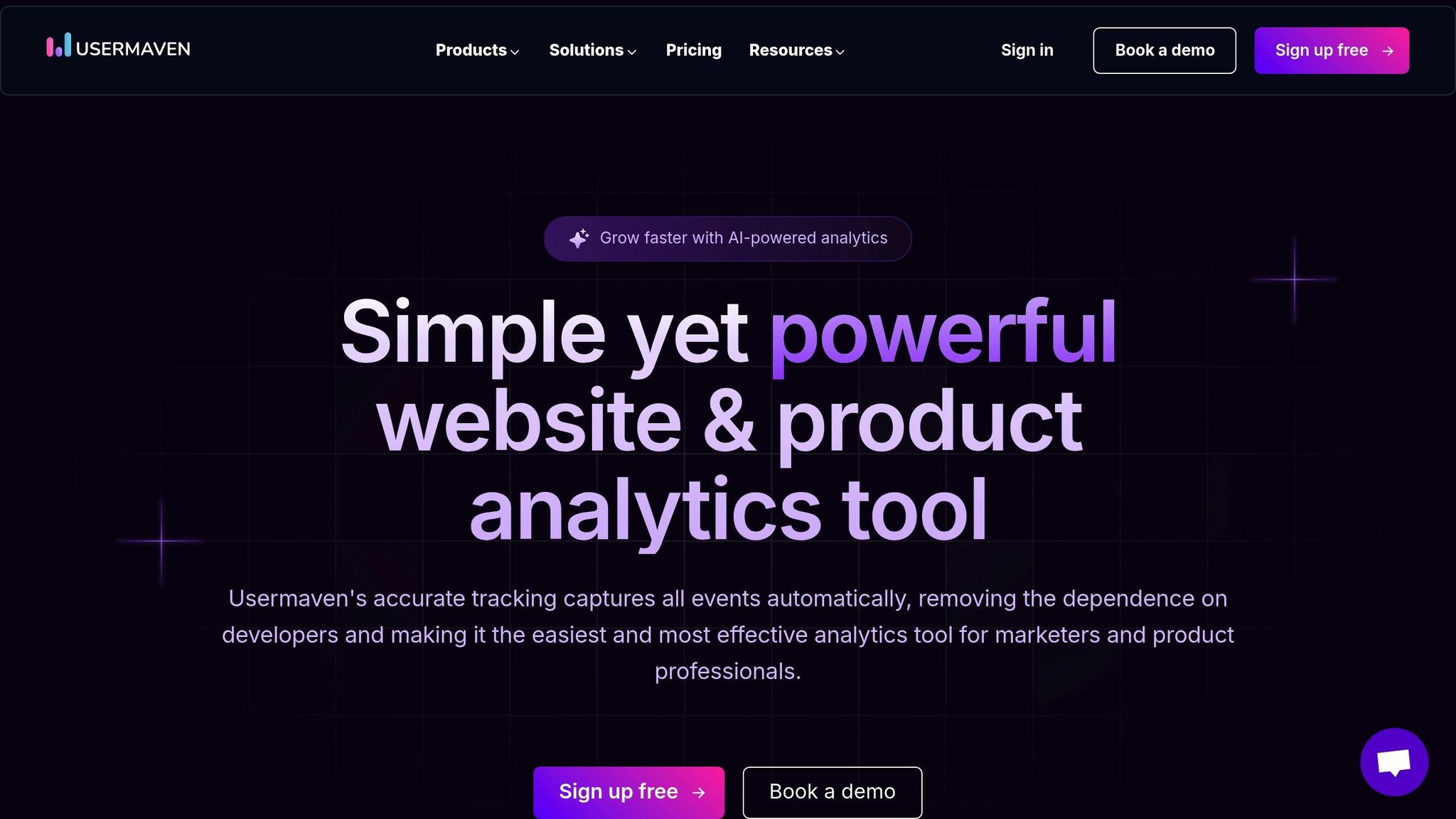
Usermaven is a privacy-first analytics platform that takes audience segmentation to the next level with dynamic, real-time data analysis. Unlike older, static tools, Usermaven automatically adjusts audience segments as user behavior evolves, keeping insights fresh and actionable.
Creating dynamic segments is straightforward – just a few clicks, and you can define rules based on user behavior, demographics, or engagement patterns. This eliminates the hassle of manually updating segments while ensuring marketers always have up-to-date insights. The platform’s real-time, privacy-conscious analytics make it a standout choice.
Real-Time Analytics Capabilities
Usermaven’s dynamic segmentation is paired with powerful real-time analytics. Its dashboard refreshes pageviews every 30 seconds, offering immediate visibility into user activity.
The real-time segmentation allows marketers to act quickly. For example, you can identify users who abandoned their shopping carts and send them personalized discounts at just the right moment to encourage a purchase. This proactive approach can significantly boost customer retention.
Ebusian Benjamin, Founder at Redink, shared his thoughts on the platform:
Usermaven is certainly a game-changing tool for my startup.
Privacy Compliance for U.S. Markets
Usermaven is fully compliant with GDPR and CCPA, offering features like data deletion, breach notifications, and a cookieless analytics approach. The platform stops using personally identifiable information within 37 months of the last user activity and ensures complete data deletion from archives within six years.
Its cookieless analytics approach ensures insights are gained without invasive tracking, keeping user privacy at the forefront. All data is securely hosted in EU-based data centers, meeting stringent privacy standards.
For businesses needing formal agreements, GDPR Data Processing Addendums can be requested by emailing privacy@usermaven.com. Data deletion and export requests can be sent to support@usermaven.com.
Integration with Marketing Platforms
Usermaven integrates seamlessly with a range of tools, including:
It also supports tracking across platforms and frameworks like JavaScript, Google Tag Manager, React.js, Next.js, Python, WordPress, Shopify, Bubble, Wix, Webflow, and SquareSpace.
Linda Johnson, an agency owner, highlighted the platform’s ease of use:
Just moved all my clients’ sites from Google Analytics to Usermaven because it’s simple, fast and gets the job done.
Usermaven goes beyond basic integrations with features like UTM parameter reporting, which enhances data filtering and analysis. For Google Ads, it offers tailored attribution models, cross-channel tracking, a 180-day lookback window, and detailed reporting using Ad IDs and UTM parameters – making it a robust addition to any marketing setup.
Use Case Versatility
Usermaven’s dynamic segmentation is particularly useful for e-commerce, SaaS, and B2C businesses that need to adapt quickly to shifting customer behavior. For e-commerce, the platform integrates with WooCommerce and Shopify to track purchase journeys and customer behavior in detail. SaaS companies can monitor user engagement and detect churn risks in real time. Its zero-code event tracking makes it accessible for businesses of all sizes, from startups to large enterprises.
With a 4.9 rating on platforms like Product Hunt, Capterra, G2, GetApp, and Software Advice, Usermaven has earned the trust of top brands and agencies. Its focus on simplicity and powerful analytics with minimal effort makes it an appealing choice for businesses looking for efficient audience segmentation tools.
8. SuperAGI
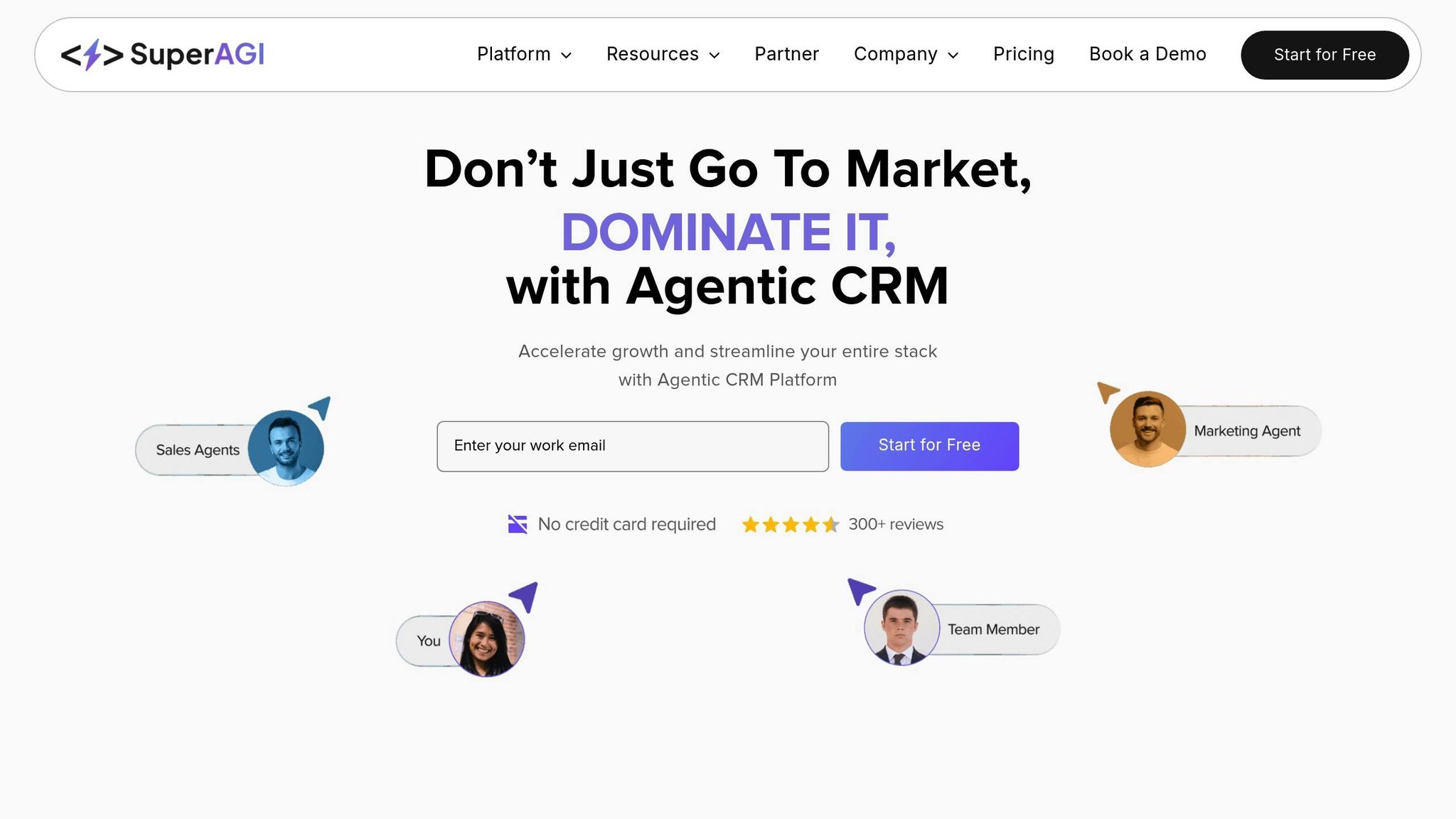
SuperAGI is an Agentic CRM platform designed to transform how businesses approach audience segmentation. By harnessing key customer data, it enables companies to create real-time, targeted audiences with a unified perspective. For instance, a prominent retail brand reported a 25% boost in sales within just six months of using SuperAGI.
The platform capitalizes on the growing demand for AI-powered, real-time segmentation, blending advanced CRM tools to support more precise and effective marketing strategies.
Real-Time Analytics Capabilities
SuperAGI’s audience builder uses predictive machine learning to analyze customer interactions as they happen. This real-time analysis results in sharper segmentation, allowing businesses to fine-tune their marketing efforts. Companies using SuperAGI have reported a 35% improvement in marketing campaign effectiveness and a 25% drop in customer churn within the first six months.
An expert from SuperAGI highlighted the value of these capabilities:
"AI-driven customer segmentation is no longer a luxury but a necessity for businesses aiming to stay competitive. Tools that can integrate with multiple platforms and provide real-time insights are crucial for creating highly targeted audiences and enhancing customer engagement."
Integration with Marketing Platforms
SuperAGI’s SuperMarketing feature ensures seamless engagement with individual customers across multiple channels. It works effortlessly with email, SMS, WhatsApp, mobile platforms, Facebook, and Google, providing broad multi-channel outreach. The platform also integrates with marketing automation tools like HubSpot and Marketo. These integrations have led to a 25% increase in qualified leads and a 30% reduction in sales cycle length. For businesses with unique requirements, custom APIs enable smooth integration with their existing systems.
These integrations make SuperAGI a versatile tool across industries.
Use Case Versatility
SuperAGI is tailored for industries such as e-commerce, SaaS, and B2C. It automates lead research and data enrichment, integrates with existing CRM systems, and streamlines sales processes to drive predictable revenue growth. Businesses using these tools have seen a 25% boost in sales productivity and a 15% reduction in sales cycles.
The platform also includes a Customer Data Platform that consolidates data from multiple sources and an AI Journey tool to design and automate multi-step, cross-channel campaigns tailored to specific audience segments. With flexible and scalable pricing options, SuperAGI ensures accessibility for businesses of all sizes.
As the SuperAGI team puts it:
"We here at SuperAGI believe that every business deserves access to these kinds of insights and capabilities. That’s why we’re dedicated to providing the tools and resources needed to implement AI-driven segmentation and start seeing real results."
9. Bloomreach

Bloomreach is transforming how businesses approach audience segmentation with its unified customer data engine. Trusted by over 1,400 global brands, the platform merges Bloomreach Engagement‘s customer data capabilities with Bloomreach Discovery‘s advanced search algorithms to deliver real-time, personalized experiences.
At its core, Bloomreach creates a comprehensive view of the customer while offering dynamic segmentation tools. Powered by its AI engine, Loomi, the platform analyzes demographic, behavioral, and contextual data to craft tailored product recommendations and merchandising strategies that adapt instantly to customer actions.
Real-Time Analytics Capabilities
Bloomreach’s real-time segmentation tools enable businesses to personalize customer experiences as they happen. By leveraging a website pixel that integrates with existing data systems, the platform captures and processes customer behavior instantly. This allows businesses to create custom metrics that combine historical insights with live data. On average, companies using real-time segmentation have reported a 12% boost in revenue per visitor.
One practical application is the ability to optimize discount campaigns. For instance, businesses can exclude customers with an 80% or higher likelihood of purchasing from receiving discounts, ensuring incentives are reserved for undecided buyers. Additionally, when an engaged visitor shares their email, the system immediately updates their profile and reclassifies them as a loyal customer, unlocking new engagement opportunities.
These real-time insights are further enhanced by Bloomreach’s robust integration capabilities, making personalization even more impactful.
Integration with Marketing Platforms
Bloomreach’s Omniconnect feature simplifies the integration of third-party data into Bloomreach Engagement, supporting tools like customer service platforms, payment systems, loyalty programs, and booking systems. The platform also enables retargeting through major advertising channels, including Facebook, Google, and AdForm. With over 90 integrations available via Patchworks, Bloomreach connects with systems across Advertising, Analytics, CRM, E-commerce, Email Marketing, and Marketing Automation. Moreover, Celigo integrations help enrich customer profiles, enabling more precise interactions and targeted marketing efforts.
This seamless connectivity allows businesses in various industries to implement sophisticated segmentation strategies with ease.
Use Case Versatility
Thanks to its real-time insights and extensive integration options, Bloomreach is particularly effective in industries like e-commerce and B2C, where personalization has a direct impact on results. The platform’s customer data engine offers analytics and reporting tools adaptable to different business models. Its flexibility allows companies to define custom segments and metrics tailored to their specific goals, making it a fit for both small online retailers and large enterprise brands. With these tools, businesses can create highly targeted segments that respond instantly to changes in customer behavior.
10. Qualtrics

Qualtrics takes audience segmentation to the next level by combining AI and machine learning with data from diverse sources like call centers, chats, social media, reviews, and surveys. With 80% of the Fortune 100 relying on the Qualtrics Experience Management Platform, it’s a go-to solution for large-scale organizations looking to refine their customer insights.
The platform uses advanced analytics to uncover new customer segments automatically. By analyzing emotion, intent, and sentiment across various customer interactions, Qualtrics empowers businesses to create dynamic segments that consider both direct feedback and indirect signals.
Real-Time Analytics Capabilities
Qualtrics’ Experience iD feature delivers real-time, omni-channel analytics by grouping customers based on their emotional responses, intent, and sentiment. It combines direct feedback, such as post-transaction surveys, with indirect signals from online reviews and social media posts to build detailed customer profiles. This approach is especially valuable in industries where emotions heavily influence decision-making. Christopher Colley, Global Head of Industry Advisory for Financial Services at Qualtrics, highlights this:
"When it comes to personal or business finances, feelings play a major role, so having tools to listen to customers and analyze emotion and intent, and then acting on insights uncovered are key to improving customer experience and loyalty."
With nearly 90% of CX leaders using data modeling and text/voice data to predict customer outcomes, Qualtrics’ machine learning capabilities continually identify new segment opportunities. These real-time insights are paired with strong privacy measures, ensuring businesses can act confidently on the data they gather.
Privacy Compliance for U.S. Markets
Qualtrics meets strict U.S. privacy and security standards, including FedRAMP authorization, which ensures the platform is secure enough for federal agencies to use for sensitive audience segmentation projects. Nick Sinai, Former U.S. Deputy CTO, explains the importance of this:
"The FedRAMP cloud security authorization is based on a rigorous process and high standards to manage risk. Modernizing government needs the scalability, agility, and security of cloud technologies, and FedRAMP is designed to accelerate the adoption of secure cloud and software-as-a-service solutions in federal government. I’m excited that Qualtrics has earned this FedRAMP authorization at a time when agencies are focusing on improving employee and customer experiences at scale."
Beyond U.S. standards, the platform also complies with the EU-U.S. Data Privacy Framework, UK Extension, and Swiss-U.S. Data Privacy Framework, enabling smooth cross-border data handling. To further protect sensitive information, Qualtrics offers a Sensitive Data Policy tool that flags sensitive data requests, notifies respondents, and redacts sensitive information during segmentation processes. Additional certifications, such as SOC 2 Type II, ISO 27001/27017/27018/27701, and HITRUST, underscore its emphasis on data security.
Use Case Versatility
Qualtrics isn’t just about segmentation – it offers flexible CX solutions tailored to various industries. Its tools are particularly effective in e-commerce, SaaS, and B2C sectors, where customer experience directly impacts revenue. The platform specializes in optimizing web UX, in-app experiences, e-commerce interactions, and digital journeys. This focus is crucial, as brands with superior CX can generate 5–6 times more revenue than competitors, yet 43% of brands still struggle with low CX maturity.
A standout example of its impact comes from retail giant Carrefour, which used natural language processing through Alterna CX to analyze customer feedback. By grouping comments by topic and sentiment, Carrefour discovered that delivery times were a major pain point. This insight allowed them to refine logistics operations, improving the overall customer experience. With 80% of companies planning to increase investment in CX initiatives, Qualtrics addresses the challenge many firms face: turning siloed data into actionable insights. Its unified approach helps businesses break down barriers, enabling them to make data-driven decisions that lead to measurable improvements.
Tool Comparison Table
Here’s a quick overview of the top 10 AI segmentation tools, covering features, use cases, pricing, and privacy compliance. This breakdown is designed to help you find the best tool for your specific needs and budget.
| Tool | Key Features | Best Use Cases | Pricing Range | U.S. Privacy Compliance |
|---|---|---|---|---|
| Lifemind | Behavioral analytics, predictive modeling | E-commerce, retail personalization | Custom pricing | CCPA compliant |
| Optimove | Multi-channel orchestration, predictive segmentation | Retail, gaming, subscription services | Not publicly available | GDPR, CCPA compliant |
| Segment.io | Real-time data collection, customer journey mapping | SaaS, mobile apps, e-commerce | $120/month (Team), $360/month (Business) | SOC 2, GDPR, CCPA compliant |
| Dynamic Yield | Real-time personalization, A/B testing | E-commerce, media, travel | Custom enterprise pricing | GDPR, CCPA compliant |
| Kissmetrics | Funnel analysis, cohort tracking | SaaS, subscription businesses | Custom pricing | GDPR, CCPA compliant |
| Mailchimp | Email segmentation, automation workflows | Small to medium businesses, content marketing | Free plan available, paid from $10/month | GDPR, CCPA compliant |
| Usermaven | Product analytics, user behavior tracking | SaaS, mobile apps | Freemium model | GDPR, CCPA compliant |
| SuperAGI | Unified customer data, real-time insights | Enterprise, multi-channel marketing | Not publicly available | Enterprise-grade security |
| Bloomreach | AI-powered personalization, commerce optimization | E-commerce, retail | Custom pricing | GDPR, CCPA compliant |
| Qualtrics | Experience management, sentiment analysis | Enterprise, financial services, healthcare | Custom enterprise pricing | FedRAMP, SOC 2, GDPR, CCPA |
Key Insights
- Pricing: Options range from Mailchimp’s free plan to custom enterprise pricing for tools like Qualtrics and Dynamic Yield.
- Privacy Compliance: Tools like Segment.io and Qualtrics stand out with certifications such as SOC 2 and FedRAMP, ensuring robust data security and compliance.
Recommendations by Business Type
- E-commerce: Tools like Dynamic Yield and Bloomreach shine with their real-time personalization capabilities, making them ideal for retailers looking to enhance customer experiences.
- SaaS Companies: Segment.io and Kissmetrics are tailored for tracking user journeys and managing subscription metrics.
- Enterprises: For advanced analytics and scalability, Qualtrics and SuperAGI are excellent choices. For example, an e-commerce company using SuperAGI reported a 32% boost in campaign performance and a 25% drop in customer acquisition costs. Similarly, HubSpot increased customer lifetime value by 25% with AI-driven segmentation.
- Small Businesses: Mailchimp and Usermaven are great starting points for businesses new to segmentation.
- Mid-Market Companies: Segment.io and Dynamic Yield offer valuable features for businesses looking to scale their segmentation efforts.
"Customer segmentation software uses AI, machine learning, and real-time analytics to automatically identify patterns in customer behavior, resulting in more accurate and actionable insights." – Arslan Jadoon, Industry Expert
Each of these tools integrates seamlessly with major marketing platforms, enabling businesses to build a targeted, AI-driven strategy tailored to their unique needs.
Conclusion
AI-powered segmentation tools are reshaping how businesses connect with their audiences by enabling highly targeted, data-driven campaigns. Considering that nearly half of marketers (49%) often feel like they’re making decisions based on guesswork, these tools offer much-needed clarity and precision in an increasingly competitive market.
The results speak volumes. Companies leveraging AI segmentation have reported a 45% increase in engagement and a 30% boost in conversion rates within just six months. Major players like ASOS have seen $77.5 million in additional revenue, while Netflix saves an impressive $1 billion annually by keeping churn rates as low as 2.4%. With the ability to process real-time data and deliver personalized experiences, AI segmentation has driven purchase rates up by as much as 89%, proving that these tools are more than worth the investment.
Christina Inge puts it best:
"There is a saying going around now – and it is very true – that your job will not be taken by AI. It will be taken by a person who knows how to use AI. So, it is very important for marketers to know how to use AI."
With tools like Lifemind and Qualtrics delivering measurable results, it’s no wonder that 72% of businesses are now adopting AI, and over 70% of top executives are prioritizing advanced AI solutions. Early adopters are positioning themselves for long-term success in this rapidly evolving landscape.
The next step is simple: pick a tool that aligns with your business goals and launch a targeted campaign. Whether you go with Mailchimp’s user-friendly features or Qualtrics’ powerful analytics, these tools equip marketers to scale their efforts and achieve lasting growth.
FAQs
How do AI tools protect customer data and ensure compliance with privacy regulations during audience segmentation?
AI tools protect customer data and uphold privacy standards through methods like data anonymization, encryption, and secure storage practices. These techniques help shield sensitive information and build trust with customers.
Moreover, these tools comply with major privacy laws like GDPR and CCPA by including features such as consent management and data access controls. This ensures data is managed responsibly, ethically, and in alignment with legal requirements.
What are the main benefits of using AI tools for audience segmentation in small and medium-sized businesses?
AI tools for audience segmentation offer small and medium-sized businesses (SMBs) a powerful edge. They help pinpoint the right audience groups, allowing businesses to craft personalized messages that truly connect with their customers. This approach not only boosts engagement but also improves customer satisfaction and delivers a stronger return on investment (ROI).
Beyond that, these tools streamline tedious tasks like analyzing customer data and setting up targeted campaigns, freeing up time and resources. They also provide a clearer understanding of customer behavior, making it easier for SMBs to spot potential leads and fine-tune their strategies for greater impact. By tapping into the capabilities of AI, businesses can make smarter, data-backed choices and stay ahead in today’s fast-moving market.
How can businesses use AI tools to integrate audience segmentation into their marketing platforms for better campaign results?
Businesses can take their marketing campaigns to the next level by incorporating AI-powered audience segmentation tools into their current platforms. The first step is to set clear goals and choose AI tools that match your specific objectives. Make sure your data is well-organized, accurate, and adheres to privacy laws. After selecting the right tools, integrate them smoothly with your existing systems, such as email marketing platforms, social media channels, or CRM software.
To get the most out of these tools, keep a close eye on your campaign performance and use insights from AI analytics to fine-tune your strategies. This not only boosts your ROI but also helps you stay in tune with evolving customer preferences.







